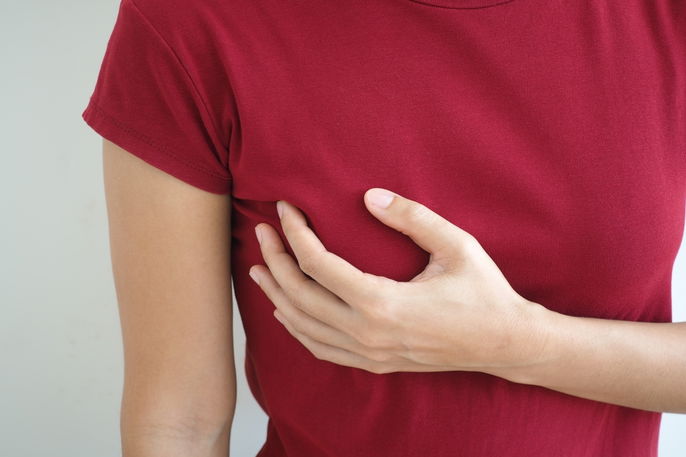Puffy nipples can occur due to several factors, such as hormonal fluctuations, friction, breastfeeding, or piercings. They may also be linked to conditions like mastitis, breast engorgement, or, in rare cases, inflammatory breast cancer.
This symptom can appear with additional signs such as swelling, pain, redness, or discharge, depending on the underlying cause. While puffy nipples are often temporary and harmless, persistent or worsening symptoms may indicate a more serious issue.
Treatment for puffy nipples depends on the cause and may include cold compresses, ointments, medications like antibiotics or anti-inflammatories, or in some cases surgery. Early identification and appropriate care can help relieve discomfort and prevent complications.

Why are my nipples puffy?
The main causes of puffy nipples are:
1. Friction
The nipple can also become puffy and irritated due to simple factors like friction caused during breastfeeding, physical or sexual activity.
What to do: To prevent nipple injuries and friction, you can lubricant ointments like petroleum jelly or zinc oxide, before and after exercising and after sexual activity.
For breastfeeding mothers, this problem can be resolved by applying a drop of milk to the nipple after each feeding or a lanolin ointment. If pain during breastfeeding is very severe, the mother can express the milk manually or with a pump and feed it to the baby with a bottle until the nipple improves or completely heals. There are also breastfeeding flanges that can be applied over the nipple to reduce pain during suckling.
2. Contact dermatitis
Puffy nipples can result from a condition called contact dermatitis. This skin conditions is characterized by an exaggerated skin reaction to a certain substance or object, and leads to symptoms such as redness, itching, swelling and peeling.
What to do: Avoid further contact with the irritating substance and rinse the nipple with plenty of cold water. In some cases, the doctor may also prescribe a corticosteroid cream or an antihistamine until symptoms improve.
3. Mammary duct ectasia
Mammary duct ectasia, also called duct ectasia, is a breast condition describing a dilated milk duct behind the nipple. It fills with fluid and can become blocked or obstructed, leading to mastitis. It usually occurs during or after menopause. Some of the symptoms that may occur include nipple discharge, tenderness, redness, swelling, and inverted nipples.
What to do: Mammary duct ectasia may not require treatment and may heal on its own. However, if persisting symptoms can be treated with antibiotics or even surgery in some cases.
4. Piercings
Placing a piercing in one or both nipples can cause inflammation in the area, either due to the body's response to the piercing or due to infection. This can lead to the appearance of symptoms, such as nipple hardening, pain, discharge, increased sensitivity and pain.
What to do: Infected or swollen piercings should be kept clean and dry. The doctor may prescribe anti-inflammatory medications and antibiotics. Read more about the symptoms of an infected piercing and the aftercare required to speed-up recovery.
5. Menstruation
In the last 12 days of the menstrual cycle, which corresponds to the luteal phase, there is an increase in progesterone and estrogen levels in the blood. This causes symptoms such as nipple and breast sensitivity, mood changes and swelling.
What to do: Since menstruation is a physiological change that is expected, no interventions are necessary. However, in cases with very intense symptoms, you should see a doctor for assessment and treated. The doctor may prescribe analgesics or contraceptives.
6. Inflammatory breast cancer
Inflammatory breast cancer usually starts with a feeling of thickness, swelling, or heaviness in the breast rather than a noticeable lump.
Doctors aren’t sure what causes this type of breast cancer, but they know it’s more common in women over 40, those who are Black, and those who are overweight.
What to do: Because inflammatory breast cancer is aggressive and spreads quickly to the skin of the breast, doctors often recommend starting with chemotherapy to shrink the tumor and reduce inflammation. Targeted therapy is usually given at the same time. If the cancer responds well, a mastectomy and removal of lymph nodes may also be recommended.
7. Breast engorgement
Breast engorgement is a common cause of breast swelling in breastfeeding mothers. It typically happens during the first week after birth, when the mammary glands start producing milk. It can also cause the breasts to feel warm, tender, or painful.
Engorgement can make it harder for milk to flow and for the baby to latch properly. If it’s not managed, it can lead to a breast infection called mastitis.
What to do: To relieve engorgement, it’s recommended to breastfeed every one to three hours or use a breast pump to express milk. A doctor may also prescribe medications to reduce inflammation and pain. Additionally, applying cold compresses to the breasts can help decrease swelling.
8. Mastitis
Mastitis is characterized by inflammation of the breast and causes symptoms such as pain, swelling or redness. This inflammation can develop into an infection and cause fever and chills.
Mastitis is more common in women who breastfeed, especially during the first three months. In these cases, it occurs due to obstruction of the milk ducts, or the entry of bacteria into the ducts. However, mastitis can also occur in men or at any other stage of a woman's life due to the entry of bacteria into the breast through a nipple injury.
What to do: Mastitis treatment involves rest, increased fluid intake, analgesics and anti-inflammatories. Infections can be additionally treated with antibiotics.






























